Changing Paintings After They are “Finished”

The monthly ArtSmart Roundtable brings together some of the best art-focused travel blogs to post on a common theme. This month we are discussing Concepts in Art! Take a look at all the creative interpretations of his topic at the bottom of the page.
Art museums are sometimes criticized for being stale and distant. Mill about, look at the pieces, and under no circumstances do you touch the art! Paintings haven’t always received this degree of reverence. While today we analyze the artist’s intent and interpret the underlying meaning of the work, for centuries paintings we just decorations. Owners could change something as easily as we repaint a bookcase or substitute a bathroom light fixture. So today I want to think about the concept of “finished” art and what it means when paintings are changed by people other than the original artist.
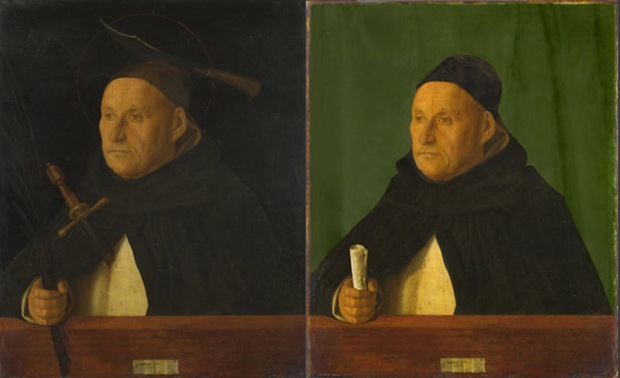
(left) “A Dominican, with the Attributes of Saint Peter Martyr” by Giovanni Bellini and (right) a digitally created image based on scientific data illustrating what the original Bellini painting would have looked like. Later alterations transformed the naturalistic portrait into a devotional religious painting. National Gallery, UK (Images)
The first caveat I need to make is that artist do alter their paintings. This is a natural part of the creative process; but importantly, it is done by the artist and is contemporary to the piece. Picasso famously reused canvases during his poorer days; I’ve written before about his masterpiece “The Old Guitarist” which is not so subtly painted over an earlier portrait of a woman. Scientific analysis of materials, examination of brushwork, and stylistic connoisseurship helps art historians determine whether something was re-worked by an artist or is a later addition.

Even professional artists make mistakes. In this large altarpiece, “Death of the Virgin” (1501), Hans Holbein the Elder initially painted the Virgin’s hand too small. Taken in the context of the whole piece, he decided they needed to be enlarged and so he used thin layers over this already dried section. Cleaning and wear over the centuries has removed the corrections revealing the first “draft” of the hand. (Kunstmuseum, Basel)
To be clear, I’m not talking about changes made by the artist. Here we’re talking about when the painting’s owner, potentially centuries later, decides he or she knows better than the original artist.
Switching Up the Subject Matter
Is there a little something you didn’t like about your painting? It’s easy enough to make small changes and completely alter the meaning of a painting. Owners felt no reservation about hiring someone to over-paint and rework a piece of art. Paintings were like any other decorative object and you could alter them as needed.
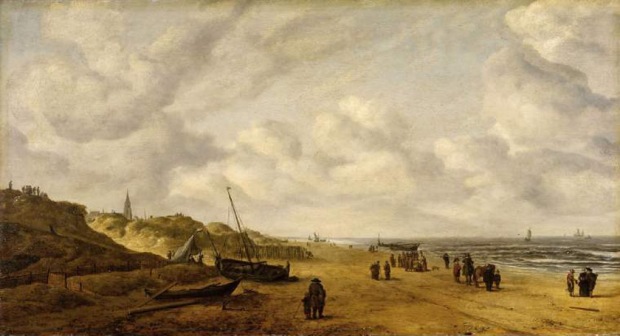
Hendrick van Anthonissen, “View of Scheveningen Sands” as received. (Photo: Fitzwilliam Museum, Cambridge, UK).
During routine conservation and cleaning, the Fitzwilliam Museum in Cambridge, UK discovered something hidden in “View of Scheveningen Sands” by Hendrick van Anthonissen. This 17th century Dutch painting depicted a calm beach scene but a section of the piece had been clearly over-painted.

Hendrick van Anthonissen, “View of Scheveningen Sands” following restoration and removal of 19th century overpainting. (Photo: Fitzwilliam Museum, Cambridge, UK).
Conservators decided to remove the over-painting which they believed dated to the 18th or 19th century. Underneath was a beached whale! The crowd is gathered not to enjoy the day but to gawk at the creature. In 17th century Holland, whales were often depicted as sea monsters so this somewhat naturalistic and innocent portrait is helpful for understanding evolving attitudes at the time. Maybe as whaling declined or went out of fashion, the animal was covered up to make this more of a traditional Dutch seascape. By restoring the whale, we can now see who very different the original painting was.
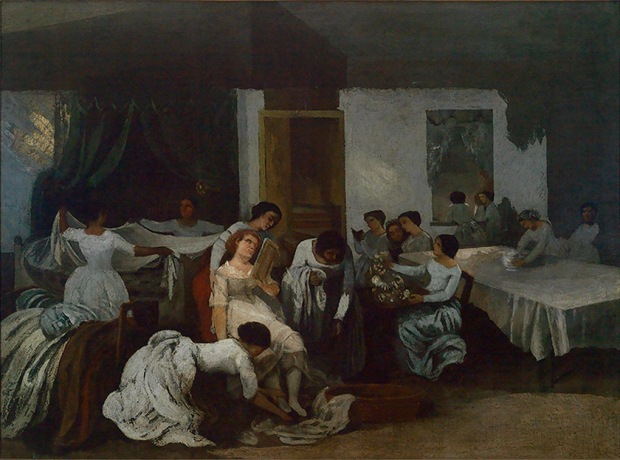
Gustave Courbet’s “Dressing of the Bridge (Preparation of the Dead Girl)” (1855), Smith College Museum of Art, USA (Photo)
In Courbet’s “Preparation of the Bride“, three attendants dress a reclining woman while two others prepare the marital bed and one prepares flowers. This seems like a normal enough scene except there are three other women intently reading from prayer books suggesting that something isn’t right here.

Composite x-ray images of Gustave Courbet’s “Dressing of the Bridge (Preparation of the Dead Girl)” which shows the changes made to the subject via later over-painting. (Images: Smith College)
X-ray analysis showed that the “Bride” was originally nude, her hand resting on her thigh while her head hung forward. This analysis enabled art historians to correctly identify the painting as Courbet’s “Preparation of the Dead Girl” (1855) which had long been considered lost. Now we can interpret the attendants as washing the body while others prepare for her wake.
It’s not surprising why this work was repainted. While countryside funerary rituals would have been fascinating to Courbet, art collectors likely found this subject matter disturbing. Since Courbet’s records always refer to the subject as a dead girl, the woman was probably repainted after Courbet’s death to make the painting more commercially desirable.
Aesthetics and the Owner’s Preference
The contemporary concept of beauty can also change over time. Paintings can be “freshened up” to be more visually pleasing or more fashionable. Like the strips of cloth famously painted into Michelangelo’s “Last Judgement” in the Sistine Chapel, morality and modesty could added to an older painting.
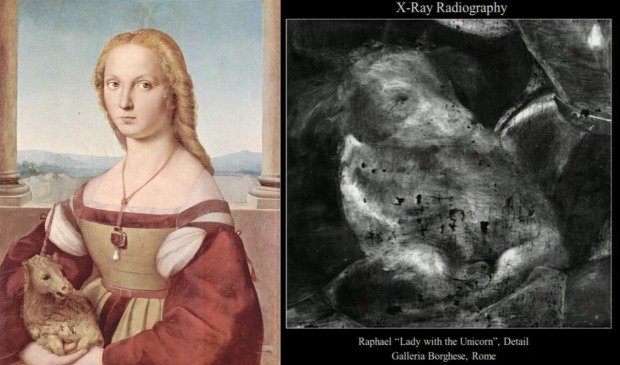
(left) Raphael, “Portrait of a Young Womwn with Unicorn”, Galleria Borghese, Rome; (right) X-ray analysis of the “unicorn”. (Image, Image)
Raphael’s “Portrait of a Young Woman with Unicorn” (1503) is one of three incarnations of this painting. In the early 20th century, she appeared as Catherine of Siena cradling a wheel in her arms. This saintly over-painting was removed to reveal a unicorn (i.e. a medieval symbol of purity) in her arms. But even this was an over-painted addition! X-ray analysis shows that the woman originally held a dog, a symbol of fidelity, in her arms. Changing tastes and purposes had recast the woman in two subsequent alterations.

Alessandro” Allori, “Portrait of Isabella de’ Medici” with partial over-paint, Carnegie Museum of Art (Photo: CMOA)
The Carnegie Museum of Art in Pittsburgh, PA originally thought their painting of Isabella de’ Medici (1542–1576) was a 19th century fake. Her face was a little too Victorian and a little too pretty. As restorers started examining the painting, they realized the work was in fact from the 16th century but had been over-painted in select places. The decision was made to uncover the painting and see what was actually underneath.
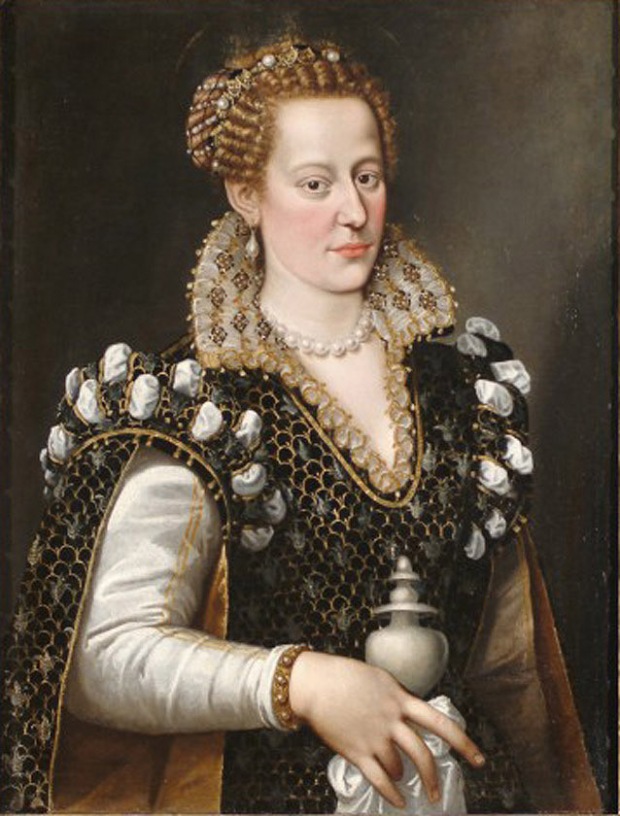
Alessandro Allori’s “Portrait of Isabella de’ Medici” following cleaning and restoration to the original 1574 image. (Photo: CMOA)
Amazing the face and hands of the woman had been repainted to be more graceful and lovely by 19th century standards. In the restored image, we actually see an older, more humble Isabella. After a life of misdeeds, she is trying to rehabilitate her image by depicting herself with the symbolic alabaster jar of reformed prostitute Mary Magdalene. Conservators even found a faint halo around her head. While the portrait is not as “pretty”, this image tells us more about the historic woman and the sitter’s intent with this painting.

(Left) Northern Italian, “Woman at a Window” (circa 1510-30) after restoration, (right) the same painting altered in the 19th century to be less “offensive”. National Gallery of Art, UK. (Images)
Lastly, the Northern Italian renaissance piece “Woman at the Window” at first appeared to be a wide-eyed gentlewoman with brown hair, but this too was over-painting. Restoration revealed that she was a blonde courtesan. Her bodice, jaw line, pursed lips, and narrow eyes were too aggressive for Victorian audiences and were redone to mimic a more mainstream concept of beauty and decorum.
Cutting Paintings Down
When I edit travel photos, I often crop the frame to create a more interesting composition or to highlight the subject better. Digital photography lends itself to re-sizing. Paintings generally don’t, and yet some panels and canvases have been literally cut to create better images.

Viewed from below, you can see where Leonardo da Vinci, “Saint Jerome in the Wilderness” was cut apart.
Leonardo da Vinci’s unfinished “Saint Jerone in the Wilderness” was cut apart and miraculously reunited after all the pieces were found in a cobbler’s shop. Clearly someone was interested in the face of the saint and discarded the unfinished surroundings in the rest of the painting. Leonardo da Vinci was known for reworking and not finishing paintings which is likely why another well-known piece was also cut down.
The portrait of Ginevra de’ Benci at the National Gallery of Art in DC is an oddly square shape. From the lopped off inscription on the reverse of the painting, it is clear that this image was cut down. But unlike St. Jerome, the missing piece(s) did not survive.
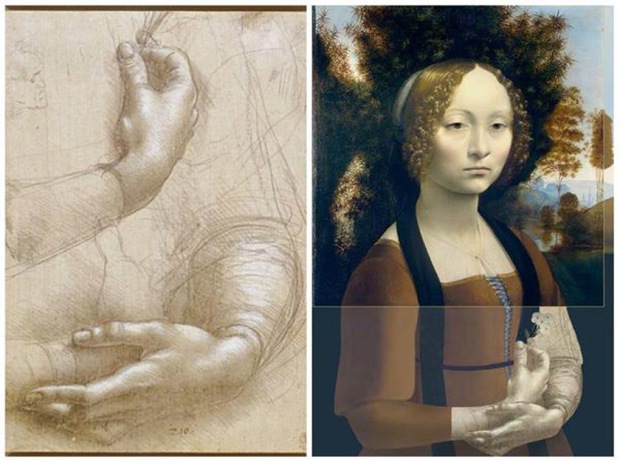
Hand sketches and a speculative reconstruction of Leonardo da Vinci’s “Ginevra de’ Benci”. (National Gallery of Art, Washington DC)
Looking at contemporary portraiture and even other works by da Vinci himself, it is likely that this would have been a full torso length painting showing the woman’s folded hands. Looking through sketches by da Vinci, the National Gallery of Art speculated on what the original painting may have looked like. Yet why would the hands have been removed? It’s possible that da Vinci (the perfectionist) hadn’t finished the hands and so a later owner trimmed the piece, salvaging the glowing face of Ginevra, and essentially creating what looked like a finished piece.
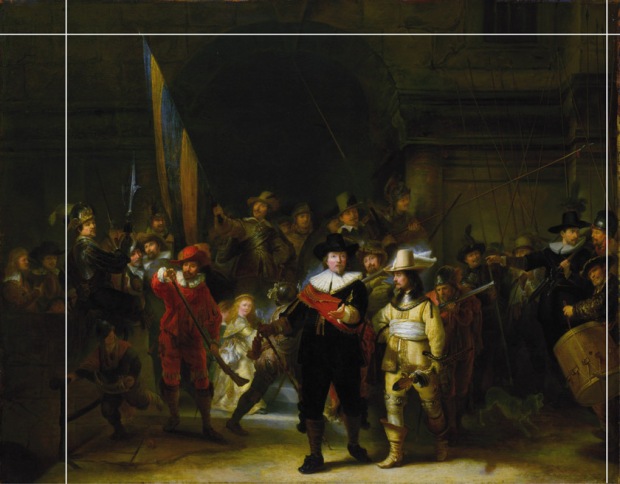
Sometimes cutting a painting is viewed as “practical”. Rembrandt van Rijn’s iconic “The Night Watch” (1642) was cut down in 1715 so that it would fit on a wall in the Town Hall. This copy of the original composition shows were the painting was trimmed. (Image)
So What is a Finished Painting?
I always enjoy seeing altered paintings and scientific analysis of the their “visual history”. It’s interesting to see the artist’s original intent and to understand the artistic desires of later viewers who changed the piece. Restoration raises some challenging questions for museums. What should the final state of the artwork be? Do you honor the original intent or maintain the well-known, albeit altered appearance?
It’s an interesting thing to ponder next time you’re standing in a quiet gallery where no one would even dream of touching a painting, let alone re-paint it.
For the rest of the October ArtSmart Roundtable, check out:
- Murissa of Wanderful Traverler – The Conceptual Design of Vancouver’s New Art Gallery
- Pal & Lydian of Art Weekenders – Earth Art – Out To Nature Back To The Gallery
- Lizzie of Wanderarti – The Concept of Travel in Art Through the Ages
- Alexandra of ArtTrav – Nurture and Hospitality at Santa Maria della Scala, Siena
- Jenna of This My Happiness – Northern California’s Greatest Artist: Wayne Thiebaud






I really enjoyed this post – so beautiful, and I learned something. Thank you!
LikeLike
Fascinating! I had no idea about these paintings. Thank you for this interesting post!
LikeLike
This is such a great topic! Love it! I’ve read about the whale story not so long ago and I find it fascinating the mystery that can be found here and there, if you look carefully enough. If I’ll come across others, will let you know to add to your article 🙂
Of course, the Nightwatch cropping is also a good story, let’s just hope no more cropping will be done in the future 😉
LikeLike
Such an interesting post – I had no idea so many paintings had been altered. It’s a bit of a shady practice (if you really think about it!) but it gives us a great idea of how mindsets changed throughout time.
LikeLike
This is fascinating. An interesting comment on body image and beauty concepts through the ages really.
LikeLike